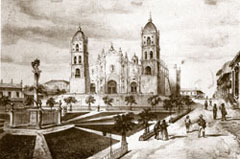4.2 First Cuban musician: Miguel Velázquez.

Miguel Velázquez is considered the first important musician born in Cuba, an organist dedicated to religious work. He was the son of a Cuban native mother and a Spaniard related to the colonizer Diego Velázquez. He studied music in Seville and Alcalá de Henares, while also pursuing a career in the ecclesiastical profession. Upon returning to his homeland, he served as a councilor for the Santiago de Cuba city council.
In 1544, he became a canon at the Cathedral of Santiago (Heredia between San Félix and Santo Tomás, Santiago de Cuba). He played the organ, knew plainchant, and performed the duties of his office, in addition to being a music and grammar teacher. In a letter from Bishop Sarmiento to King Charles V, dated July 25, 1544, referring to the mestizo musician, the priest says: “He taught grammar and led an exemplary life.”
In Spain, he learned to play the organs and became an expert in Gregorian chant. Miguel Velázquez composed motets and carols for sung services in church.
In a letter from Bishop Sarmiento to King Charles V, dated July 25, 1544, referring to the mestizo musician, the priest says: “He taught grammar and led an exemplary life.” In another letter of recommendation to the monarch, this time from the accountant Juan de Agramonte, he states: “Young in years and old in doctrine and example, through whose diligence the Church is well served.” Velázquez was a direct descendant of the conquistador, but by blood, not by ideas, because when referring to his native country, he said: “Sad land, as if tyrannized and lorded over!”








